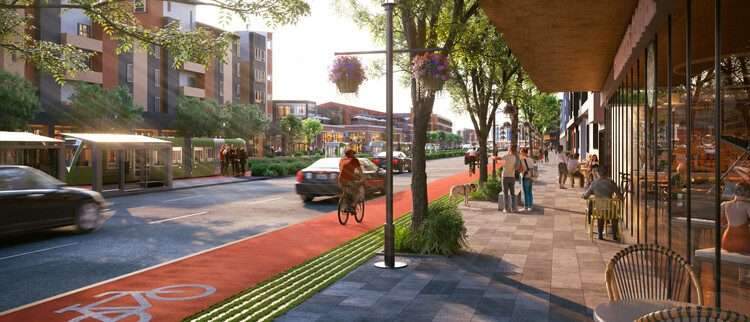
This article was originally published on Common Edge.
Architect and planner Peter Calthorpe has a new book coming out, Ending Global Sprawl: Urban Standards for Sustainable Resilient Development. But when I called Calthorpe last week to interview him about it, he was more interested in talking about something else: last year’s passage in California of AB 2011, the so-called “Affordable Housing and High Road Jobs Act of 2022.” That’s legislation intended to significantly increase housing production by allowing construction on commercially zoned property. Calthorpe had an active hand in crafting many aspects of the bill, which is scheduled to go into effect on July 1.
Calthorpe has a long history of developing, promoting, and implementing high-impact planning principles. “I never claim to invent anything, I just copy and popularize,” he says. The author of multiple books, he’s one of the founders of the Congress for the New Urbanism. In the early 1990s, he developed the concept of Transit-Oriented Development, now a foundational idea in planning and policy circles. His firm, which joined HDR in 2019, works all over the world.
Martin C. Pedersen: You have a new book on global sprawl, but you want to start somewhere else.
Peter Calthorpe: Perhaps we can talk about the book some other time. What I’m most passionate about right now is helping to pass a landmark piece of legislation here in California to address the housing crisis. And it has received very little attention. So my crusade right now is to make the rest of the country aware of its potential and that it represents a systemic solution to the housing crisis.
MCP: You were active in helping pass that legislation. What’s the background?
PC: In 2008, the paradigm for how America houses itself basically collapsed. We’ve been on automatic pilot to generate subdivisions and suburban sprawl for more than 40 years. The financial collapse of 2008 finally demonstrated that the center of the bell curve couldn’t afford it anymore. They couldn’t drive that far, couldn’t pay for the transportation costs, and couldn’t cover the mortgage. So what we came to see as financing shenanigans, the subprime stuff, I think was a way of discounting and moving the wrong kind of inventory, homes in the wrong location, the wrong size, at the wrong price.
Two things happened concurrently with that. First, middle-class wages have been stagnant for 30 years, inflation-adjusted. Second, our fundamental household demographic had shifted. We’re not dominated by families with kids, looking for a cul-de-sac and a yard, anymore. The fastest-growing demographic is single people, up 32% since 2000; then comes empty-nesters and elderly. These people’s needs are not really satisfied by large, remote, single-family homes.
Then you look at the housing data. The average size of homes has grown, while the number of people living in them has shrunk. The cost of commuting for many lower income working people is now 20% to 25% of household income. When you put that together with rent or mortgage, you’re over 50%. The cumulative mismatch of housing location and its size, with the reality of the household demographics, is stunning. Since 2008, housing production fell in half in California. Interestingly, multifamily production has now reached and actually surpassed its pre-2008 levels; single-family is now maybe 40% of its pre-2008 levels. The marketplace has already figured out that another distant subdivision isn’t a marketable solution for many working people anymore.
MCP: Of course things are particularly acute in California.
PC: Right now in California, we produce about 70,000 units a year of multifamily and about the same of single-family. It was once three units of single-family for every one multifamily, because single-family was the American Dream. As a result of the lack of affordability and the lack of production since 2008, we have an extreme housing deficit. And scarcity breeds higher values, so we have a cascading set of results, a higher demand for middle-income workforce and affordable housing with fewer units being built, resulting in higher costs that then forces some into homelessness.
Meanwhile, YIMBY groups have made a crusade out of diversifying single-family neighborhoods, adding missing-middle housing, which is a good idea—rhetorically and ideologically correct. Why should there be these wealthy enclaves with one-size-fits-all housing? Why should we divide the people who live in multifamily from the people who live in single-family? Better to mix housing types and therefore income groups and household types. But I worry that “mom and pop” and “lot by lot” redevelopment cannot produce enough housing to rebalance the needs. It’s hard for a working family to finance and manage a major rebuild on their single-family lot. ADU additions are easier.
MCP: You’ve been exploring this idea of building on disused commercial land for a while now.
PC: I started a software company years ago called Urban Footprint, which gave us the ability to do scenario modeling for different land use possibilities. So I went next door—they’re still next door—and said to Joe, “Could you do a run and identify all the strip commercial land in California, and then let’s apply a range of redevelopment densities to it.” The first experiment was El Camino, which is 43 miles from San Francisco to San Jose. It’s the old mission trail, the heart of Silicon Valley.

MCP: When did you do this?
PC: Oh, god. I did this four or five years ago. That was the first experiment, 43 miles. Lo and behold, we identified 250,000 potential units of infill housing on one strip. So then I said, “OK, let’s look at the five-county inner Bay area.” There’s 700 miles of arterials. What’s the total capacity of converting all that extremely underutilized strip commercial land, because of online shopping? So these 700 miles produced up to 1.3 million multifamily units at reasonable densities. Now, remember, this is five counties in the context of a state that’s producing just 130,000 units a year. But what’s beautiful about infill on arterials is that they are in areas with existing services and jobs. They can act as urban ribbons passing through and connect different communities. Called “grand boulevards,” the idea is not only do you build much needed housing but you improve the streets, with sidewalks, bike paths, and ground floor shops. Once you have housing density in this linear format, you can justify transit investments—transit that is more accessible and ubiquitous at a regional scale. The big idea is combining massive infill housing opportunities on underutilized land with public improvements for transit and walkable environments. Effectively transforming the worst place in a community, the arterial strip, into a livable, mixed-use boulevard.
I realized the idea needed a state-level mandate. While some cities may support such infill, many wealthier cities are against all multifamily infill. And the boulevards need continuity of development across jurisdictions. I started working in the ’70s for Jerry Brown in Sacramento, so I’ve been through that turf a bit over the years. At first I didn’t really get any traction. Then Assemblywoman Buffy Wicks, head of the housing committee, and Chief of Staff Steve Wertheim for the committee, heard about the idea. They called out of the blue, saying, “We’re doing a new housing bill, and we think we can add this commercial strip component onto it.” They were contemplating a bill for affordable housing on all commercial land. But it was 100% affordable, and given the low levels of subsidy the state puts into affordable, you’d get around 16,000 units a year. So that 100% affordable-only legislation would have a limited impact. Assemblywoman Wicks, a brilliant, strong woman from Oakland, decided to add this “grand boulevard” idea as a second section to the bill. Basically adding mixed-income, mixed-use development on most strip commercial parcels, anywhere in the state of California, “as of right,” based on a form-based code. This streamlines environmental reviews and limits the city’s ability to refuse or reduce the density and housing.
MCP: What does the code say?
PC: We didn’t want one-size-fits-all. We have four-lane roads, six-lane roads, TOD sites, sites near downtown. We have all these different conditions and needs, therefore they should have different housing types and densities providing variety on the street and different housing types for different people. And we didn’t want most of the land to be squandered on low-density, high-cost townhomes. So the law ironically sets minimum densities for each place category rather than the typical zoning for maximum densities.
We divided the sites into four categories: small lot, four lanes, six lanes, and TOD. Each one got an appropriate minimum depending on the transit potential of the street or existing stations. Each location type has a set of envelope/height limit resulting in a simple form-based code. It has a height limit, a stepping setback on the rear, and a build-to-line on the front to activate the street. The developer can choose what to build within that envelope—configuration, construction type, mix of unit sizes—as long as they exceed the minimum density, which ranges from 30 du/ac [dwelling units per acre] up to 85 du/ac. There is no maximum, just the form-based envelope.
Furthermore, there’s no parking requirements. The marketplace will decide how many parking stalls go in these places. And remember, this is all state, as of right, so the individual cities cannot disrupt the production of this housing. Now, if you want to get in the weeds, there’s some technicalities about “objective standards” that they can impose, but those standards have to be pre-existing and reasonable. They can’t be designed as a poison pill to stop the development or reduce the density.

MCP: This was passed less than a year ago. Have we seen any evidence on the ground yet that it’s working?
PC: While already passed and signed, it will go into law this coming July. But you can see a lot of it already, because some cities—Redwood City, Berkeley, and Menlo Park—had already been experimenting with the idea and zoned their strip commercial for residential. But now production will really step up. Before the bill was passed, we got a grant to model the potential housing it could produce for the whole state of California, and the number turned out to be 10 million units of capacity.
MCP: That’s the potential.
PC: But everybody said, “Yeah, but that may not happen because of market forces.” There’s a beautiful piece of software called MapCraft that we plugged into Urban Footprint. It did six pro formas for each parcel, based on local rents, construction costs, city fees, for every parcel in the state of California. It’s kind of amazing what the algorithms can do now. That came out at around 2 million units, market feasible today. With the 15% low income inclusionary requirement in the law, that results in 300,000 units of unsubsidized affordable housing. These two numbers are big enough to really impact statewide housing costs and availability, and address the needs of people most in need, working households priced out of the communities they live in. Remember, the strip is everywhere!
MCP: Those numbers roughly match the need right now, correct?
PC: Well, in California, it’s hard to get exact on the total need. There’s many different types of needs, but yes, it’s definitely at the right scale. In addition, we modeled environmental and economic results of shifting from sprawl to this type of multifamily infill, and the results were stunning. Households living on these boulevards will on average reduce greenhouse emissions 50%, driving down 55%, water consumption down 62%, and household travel and utility costs down 53%.
So now I’m working on trying to get the state to focus their sustainable community strategies and funding on this infill housing. We have the housing mandate, but the second component is to upgrade the arterials into livable, walkable, transit-rich places. We know we’re going to build dense housing on these corridors because of AB2011, so we’d better match it with infrastructure and transit dollars. That’s the next piece of legislation I’m working on. It’s a two-stage vision: mixed-income, infill housing plus infrastructure and mobility equals livable places.






